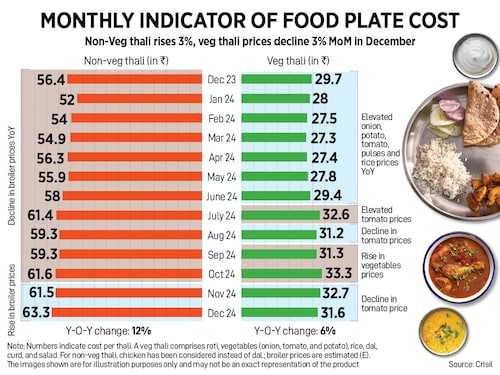How India Eats: Non-veg thali rises twice as fast as veg in December
The surge of broiler chicken prices by an estimated 20 percent year-on-year caused the increase in the cost of the non-vegetarian thali last month



Once again, raging prices of key ingredients like tomato, potato and vegetable oil have kept thali costs on the boil in December. Adding to the already elevated price is the cost of broiler chicken, which further increased the non-vegetarian thali costs in the last month of 2024.
The average cost of a home-cooked non-vegetarian thali spiked 12 percent year-on-year (YoY) in December to Rs 63.3, based on an analysis by Crisil. This compares to Rs 56.4 per thali in December 2023. On a month-on-month (MoM) basis, the non-vegetarian thali jumped 3 percent from Rs 61.5 in November.
The cost of the non-vegetarian thali grew at a faster pace due to an estimated 20 percent YoY increase in broiler prices—it was caused by a production decline triggered by the cold wave in north India. On a MoM basis, broiler chicken prices jumped 11 percent in December. “This, coupled with a rise in festive and wedding-season demand, along with an elevated feed cost, exacerbated the woes," says Crisil. Broiler chicken prices accounts for 50 percent of a non-vegetarian thali cost.

Meanwhile, the vegetarian thali got 6 percent expensive YoY, to Rs 31.6 in December. However, compared to November, the prices of the same vegetarian thali declined 3 percent from Rs 32.7. The overall rise in the vegetarian thali cost was driven by an increase in tomato and potato prices, which collectively account for 24 percent of the cost of a thali.

Adding to the cost was a 16 percent YoY jump in vegetable oil prices due to the import-duty hike and the higher demand during the festive and wedding seasons. However, an 11 percent YoY drop in LPG fuel cost provided a partial offset, says Crisil.
On a MoM basis, tomato prices fell 12 percent, helped by fresh supplies from Madhya Pradesh, Maharashtra and Gujarat. A 2 percent and 12 percent MoM drop in potato and onion prices, respectively, further supported the price decline.
(Forbes India"s monthly series "How India Eats" takes a look at how the average price of a food plate in India changes every month, indicating the impact on the common man"s expenditure, by analysing the Indian thali)
First Published: Jan 06, 2025, 12:25
Subscribe Now